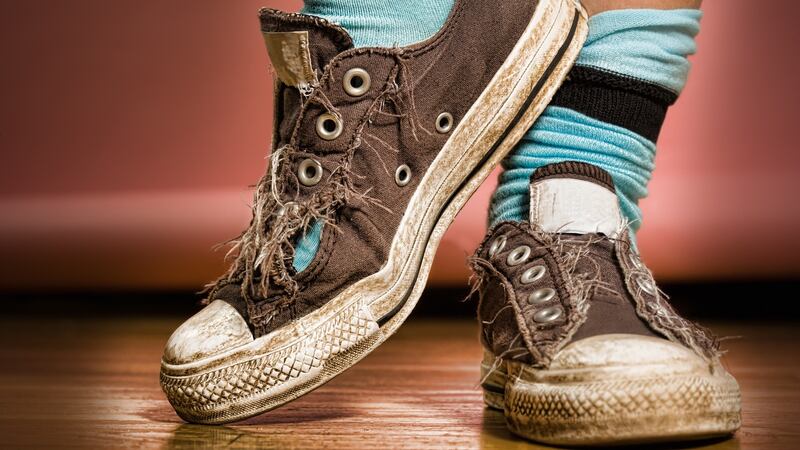Ruth Conway, from D6 Podiatry in Dublin, graduated from Manchester's Salford University in 2014 with a BSc in podiatry.
Here, she shares her tips for footcare.
– Choose shoes that are secured to your foot, so it only has to think about functioning, and is not clawing or holding the shoe on. A shoe needs a little bit of a lift. Very flat shoes, like slippers, aren’t always the best and can cause heel pain.
– If you’re going to wear a heel, choose a wedge or something that’s secured on to your foot as much as possible. Ensure there’s cushioning under the forefoot.
– A flatter foot with a pronated arch can lead to issues such as plantar fasciitis, shin splints, knee pain and hip pain. The solution can sometimes be a good structured stability runner. I like runners. I’m quite happy that children are wearing them now.
– Shoe depth is important. Corns and callouses on the tops of your toes mean you probably need to be looking for a deeper toe-box. People always think, ‘I need to buy wider shoes’, but the problem is usually that the shoe is too shallow. This can also lead to other problems including ingrowing toenails.

– Check shoes aren’t worn out. Patients often don’t link foot pain to their shoe being worn down in that spot. Feel inside your shoe. Where the ball of your foot sits can be very compacted down. This can cause pain or discomfort in your metatarsals, or your might get a corn, or lots of callous forming, because your body is trying to compensate for that lack of cushioning.
– Buy good quality breathable cotton socks. If you get swelling in the legs at the end of the day find something without too tight of an elastic at the top or around your ankles. Consider wearing socks inside out if the seam causes pressure on your toes. Seamless socks are great for diabetics.
– Don’t forget to wash your feet in the shower. It’s not enough to let water run over them. Wash between the toes and dry properly afterwards. It’s really important to wash after activities like such as, yoga and gymnastics, where you go shoeless.
– Moisturise your feet, particularly your heel. As your heel hits the ground the skin spreads a little bit, and as you get older your skin can dry out. Moisturising maintains the elasticity, so that it doesn’t rip and tear. You’re really trying to prevent portals of entry for infection, and painful fissures. A heel balm can help prevent those.
– When cutting your nails follow the natural curve, where the white tip bends around. Always cut conservatively. Keep them neat but don’t cut too far back, or down the sides. This is what can cause ingrowing toenails.
– If you do get an ingrowing toenail and it becomes irritated, a salt foot bath can offer relief until you get it treated. Use 4 tablespoons of salt to four pints of warm – not hot – water. Bathe for six-eight minutes. Salt baths are also helpful after treatment to speed up healing.
– Fungus is a common problem – 36 per cent of 30-year-olds, and 60 per cent of 60-year-olds, have a fungus on their skin. Many people mistake fungus on their feet for dry skin and moisturise, which can make it worse. The difference between dry skin and a fungal foot infection is that dry skin flakes off, while fungus affected skin will peel off in little circles.
– An itchy or red foot, or even pustules, are the common signs of athlete’s foot, tinea pedis. Over the counter anti-fungal creams and powders are very effective. It takes about two weeks to heal, but it is important to clear the fungus, to stop it travelling up the body, and because it may cause tears in skin between the toes, which can be portals for infection. In addition, as you get older you are at a higher risk of getting cellulitis if you have fungal infections on your feet. Remember that spores stay in shoes and socks so try and prevent re-infection.
Pressure
– If you think you have a verruca get it checked. It could be one of a few things. Verrucas are often confused with corns. A corn is normally painful under direct pressure. It is hard skin that has formed from a pin point of really high pressure. A verruca doesn’t have the same discomfort on direct pressure. The striations of the skin also pass around a verruca not through them. People look for the black dot, but they’re not always there.
– Be careful of home verruca treatments, which can irritate the skin, and make it worse. However, covering a verruca with kinesiology tape suffocates the wart and also prevents it spreading. Don’t use duct tape. This will damage your skin.
– Care also needs to be taken with over the counter treatments for corns. They are not suitable for diabetics, or if you have fragile skin. They can break down the skin, increase the risk of infection, and cause an ulcer, which is much more difficult to heal.
– Keep nail polish to a minimum. Wear it for maximum a week, and give your nails a break to let them recover. Use something like an almond oil, applied topically, to nourish the nails. Shellac and the permanent use of nail polish increase the risk of fungal infection because you’re causing trauma to the nail. Fungus can then enter the nail-bed.
– A new condition known as “nail degranulation” was first noticed in the 1990s following the spread of nail bars. It is a corrosion of the nail caused by chemicals, like nail polish and remover, being rapidly reused on the nails. To treat this you need to get the nail filed down by a professional, stop using nail polish for two months, and moisturise the nails with a high-urea content cream.













